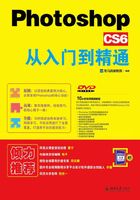
4.4 调整选区
很多时候建立的选区并不是设计师所需要的范围,这时还需要对选区进行修改。可以通过添加或删除像素(使用【Delete】键)或者改变选区范围的方法来修改选区。
4.4.1 使用【修改】命令调整选区
选择【选择】→【修改】命令可以对当前选区进行修改,如修改选区的边界、平滑度、扩展与收缩选区以及羽化边缘等,如下图所示。

1.修改选区边界
使用【边界】命令可以使当前选区的边缘产生一个边框,其具体操作步骤如下。
第1步 打开随书光盘中的“素材\ch04\4-14.jpg”文件,选择【矩形选框工具】 ,在图像中建立一个矩形边框选区,如下图所示。
,在图像中建立一个矩形边框选区,如下图所示。

第2步 选择【选择】→【修改】→【边界】命令,如下图所示。

第3步 弹出【边界选区】对话框。在【边界选区】对话框的【宽度】文本框中输入“50”像素,单击【确定】按钮,如下图所示。

第4步 其效果如下图所示。

第5步 选择【编辑】→【清除】命令(或按【Delete】键),再按【Ctrl+D】组合键取消选择,制作出一个选区边框,如下图所示。

2.平滑选区边缘
使用【平滑】命令可以使尖锐的边缘变得平滑,其具体操作步骤如下。
第1步 打开随书光盘中的“素材\ch04\4-15.jpg”文件,然后使用【多边形套索工具】 在图像中建立一个多边形选区,如下图所示。
在图像中建立一个多边形选区,如下图所示。

第2步 选择【选择】→【修改】→【平滑】命令,如下图所示。

第3步 弹出【平滑选区】对话框。在【平滑选区】对话框的【取样半径】文本框中输入“30”像素,然后单击【确定】按钮,即可看到图像的边缘变得平滑了,如下图所示。


第4步 按【Ctrl+Shift+I】组合键反选选区,如下图所示。

第5步 按【Delete】键删除选区内的图像,然后按【Ctrl+D】组合键取消选区,如下图所示。此时,一个多边形的相框就制作好了。

3.扩展选区
用户使用【扩展】命令可以对已有的选区进行扩展,具体操作步骤如下。
第1步 打开随书光盘中的“素材\ch04\4-16.jpg”文件,然后建立一个椭圆形选区,如下图所示。

第2步 选择【选择】→【修改】→【扩展】命令,如下图所示。

第3步 弹出【扩展选区】对话框。在【扩展量】文本框中输入“45”像素,然后单击【确定】按钮,即可看到图像的边缘得到了扩展,如下图所示。


4.收缩选区
用户使用【收缩】命令可以使选区收缩,具体操作步骤如下。
第1步 继续上面的例子操作,选择【选择】→【修改】→【收缩】命令,如下图所示。

第2步 弹出【收缩选区】对话框。在【收缩量】文本框中输入“80”像素,然后单击【确定】按钮,即可看到图像边缘得到了收缩,如下图所示。


|提示|
物理距离和像素距离之间的关系取决于图像的分辨率。例如,72像素/英寸图像中的 5 像素距离就比在300像素/英寸图像中的长。
5.羽化选区边缘
用户选择【羽化】命令,可以通过羽化使硬边缘变得平滑,其具体操作步骤如下。
第1步 打开随书光盘中的“素材\ch04\4-17.jpg”文件,选择【椭圆工具】 ,在图像中建立一个椭圆形选区,如下图所示。
,在图像中建立一个椭圆形选区,如下图所示。

第2步 选择【选择】→【修改】→【羽化】命令,如下图所示。

第3步 弹出【羽化选区】对话框。在【羽化半径】文本框中输入数值,其范围为0.2~255,这里输入“75”像素,单击【确定】按钮,如下图所示。


第4步 选择【选择】→【反向】命令,反选选区,如下图所示。

第5步 选择【编辑】→【清除】命令,按【Crl+D】组合键取消选区。清除反选选区后效果如下图所示。

|提示|
如果选区小,而羽化半径过大,小选区则可能变得非常模糊,以至于看不到其显示,因此系统会出现【任何像素都不大于50%选择】的提示信息,此时应减小羽化半径或增大选区大小,或者单击【确定】按钮,接受蒙版当前的设置并创建看不到边缘的选区。
4.4.2 修改选区
用户创建了选区后,有时需要对选区进行深入编辑,才能使选区符合要求。【选择】下拉菜单中的【扩大选取】【选取相似】和【变换选区】命令可以对当前的选区进行扩展、收缩等编辑操作。
1.扩大选取
使用【扩大选取】命令可以选择所有和现有选区颜色相同或相近的相邻像素。
第1步 打开随书光盘中的“素材\ch04\4-18.jpg”文件,选择【矩形选框工具】 ,在草莓中创建一个矩形选框,如下图所示。
,在草莓中创建一个矩形选框,如下图所示。

第2步 选择【选择】→【扩大选取】命令,如下图所示。

第3步 可看到与矩形选框内颜色相近的相邻像素都被选中了。可以多次执行此命令,直至选择了合适的范围为止,如下图所示。

2.选取相似
用户使用【选取相似】命令可以选择整个图像中与现有选区颜色相邻或相近的所有像素,而不只是相邻的像素。
第1步 继续上面的操作步骤。选择【矩形选框工具】 ,在草莓上创建一个矩形选区,如下图所示。
,在草莓上创建一个矩形选区,如下图所示。

第2步 选择【选择】→【选取相似】命令,如下图所示。

第3步 这样包含于整个图像中的与当前选区颜色相邻或相近的所有像素就都会被选中,如下图所示。

3.变换选区
使用【变换选区】命令可以对选区的范围进行变换。
第1步 打开随书光盘中的“素材\ch04\4-19.jpg”文件,选择【矩形选框工具】 ,在其中一张便签纸上用鼠标拖曳出一个矩形选框,如下图所示。
,在其中一张便签纸上用鼠标拖曳出一个矩形选框,如下图所示。

第2步 选择【选择】→【变换选区】命令,或者在选区内右击,在弹出的快捷菜单中选择【变换选区】命令,如下图所示。

第3步 按住【Ctrl】键来调整节点以完整而准确地选取蓝色便签纸区域,然后按【Enter】键确认,如下图所示。


4.4.3 管理选区
选区创建之后,用户可以对需要的选区进行管理,具体方法如下。
1.存储选区
使用【存储选区】命令可以将制作好的选区进行存储,以便下一次操作。
第1步 打开随书光盘中的“素材\ch04\4-20.jpg”文件,然后选择香蕉的选区,如下图所示。

|提示|
这里使用【魔棒工具】先选择白色的背景区域,然后使用【反选】命令即可。
第2步 选择【选择】→【存储选区】命令,如下图所示。

第3步 弹出【存储选区】对话框。在【名称】文本框中输入“香蕉选区”,然后单击【确定】按钮,如下图所示。

第4步 此时在【通道】面板中就可以看到新建立的一个名为【香蕉选区】的通道,如下图所示。

第5步 如果在【存储选区】对话框中的【文档】下拉列表框中选择【新建】选项,那么就会出现一个新建的【存储文档】通道文件。


2.载入选区
将选区存储好以后,就可以根据需要随时载入保存好的选区。
第1步 继续上面的操作步骤,当需要载入存储好的选区时,可以选择【选择】→【载入选区】命令,如下图所示。

第2步 打开【载入选区】对话框,如下图所示。

第3步 此时在【通道】下拉列表框中会出现已经存储好的通道的名称——香蕉选区,然后单击【确定】按钮即可,如下图所示。如果选择相反的选区,可选中【反相】复选框。
